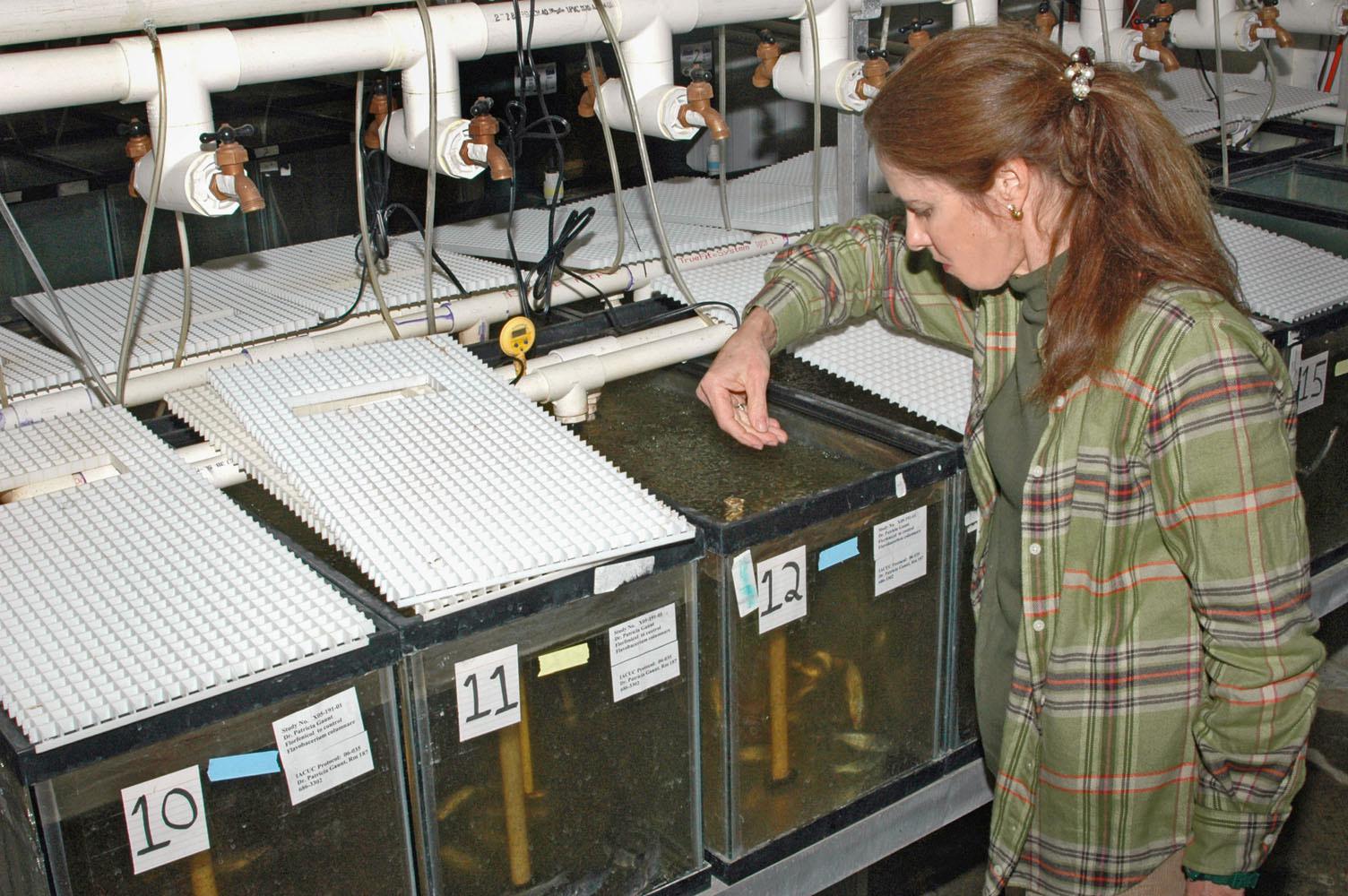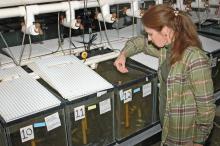Information Possibly Outdated
The information presented on this page was originally released on November 9, 2006. It may not be outdated, but please search our site for more current information. If you plan to quote or reference this information in a publication, please check with the Extension specialist or author before proceeding.
Catfish antibiotic could combat two diseases
By Robert H. Wells
Delta Research and Extension Center
STONEVILLE -- A new antibiotic for aquaculture may become twice as useful against deadly bacterial infections plaguing farm-raised catfish if it receives proposed additional labeling.
|
|
Stoneville scientists and government officials are now reviewing Aquaflor, an antibiotic made by Schering-Plough Animal Health Corp., for use in the treatment of columnaris disease in catfish. The antibiotic is already labeled for use against enteric septicemia, or ESC, another major bacterial disease of catfish.
“Columnaris and ESC are the two important bacterial infections of channel catfish,” said Pat Gaunt, interim director of Mississippi State University's aquatic diagnostic lab at the Delta Research and Extension Center in Stoneville. “According to our 2005 diagnostic lab report, columnaris is the No. 1 cause of deaths that are sent into the diagnostic lab by the catfish farmers.”
Gaunt is testing the efficacy of Aquaflor in the treatment of columnaris as part of a proposed labeling package she will send to the U.S. Food and Drug Administration. Her earlier in vitro studies show the bacteria that causes columnaris is sensitive to the antibiotic.
Additionally, Schering-Plough Animal Health is negotiating FDA's conditional approval of Aquaflor for the treatment of columnaris, Gaunt said.
“We're attacking this on both ends,” she said. “We've got the efficacy work started and Schering-Plough Animal Health is talking to the FDA about getting conditional approval under the Minor Use and Minor Species, or MUMS, Health Act of 2004 so farmers can start using Aquaflor legally in the field against columnaris.”
The Stoneville researcher said she expects labeling of Aquaflor for treating columnaris will come through the MUMS Act first.
“After the experimental study is completed, we have to submit the data for an audit, write a report, and send both the data and the report to the FDA for approval,” Gaunt said. “The entire process will take many months, maybe a year before it's completed.”
Jimmy Avery, an MSU Extension catfish specialist also based in Stoneville, said if approval is granted, an added benefit of using Aquaflor to treat columnaris is that the antibiotic would be in floating feed form.
“In the past, most of the antibiotics used for columnaris have been incorporated in sinking feed,” Avery said. “So the ability to incorporate Aquaflor in a floating feed to fight a disease like columnaris would really be a big help.”
Avery said that when using a floating medicated feed, a farmer can see if the fish actually are ingesting the medication.
“With sinking feed, you throw it out there and you don't get any feedback,” he said. “Also, when fish have been actively feeding at the surface for a long time, it's questionable how well they'll switch to feeding at the bottom.”
Aquaflor became the first FDA licensed in-feed antibiotic for U.S. aquaculture in more than 20 years when it was approved for use against ESC in channel catfish in October 2005. Commercial use of the product began in the spring of 2006.
Lab tests showed Aquaflor to be very effective against ESC and highly palatable to catfish.
Avery said farmers have been rather optimistic about the product's potential on their farms, and many have tried the antibiotic.
“I think in most cases where they've been able to get feed to the fish before the ESC infection is too advanced, they've been pleased with the effects,” Avery said.
Chris Nerren, a producer in Isola, who has farmed catfish with his family since the 1970s, treated his sick fingerlings with Aquaflor in early September to rid them of ESC.
“It cleared them right up,” Nerren said. “You could tell a big difference in a week. I was able to get them back on regular feed quickly, and it seemed like I didn't lose as many fish as I normally would due to ESC.”
For farmers to use Aquaflor, a veterinarian must diagnose their fish with ESC and write a veterinarian feed directive, or VFD, order for the product. VFD status of Aquaflor protects human health, the environment and the effectiveness of the drug, Gaunt said.
“We only have three approved aquaculture antibiotics on the market in the United States,” Gaunt said. “So if you misuse those and get the bacteria resistant to any one of them, it only leaves you with one or two more. You have to be really careful that you don't abuse it and that you make sure the bacteria remain sensitive to the antibiotic.”
Gaunt's role in bringing Aquaflor to U.S. channel catfish production has been significant, and she first considered its use while searching for a research project as an intern in Stoneville in 1997.
“I had known about florfenicol, the active ingredient in Aquaflor, because it was used in beef cattle, and as a veterinarian, I was aware of the drug,” Gaunt said. “It was used in other parts of the world in aquaculture but was not approved in the United States. I called a representative of Schering-Plough Animal Health, and they agreed to look at a protocol I designed to test the efficacy of the antibiotic against the bacteria that causes ESC of catfish. They liked the protocol and agreed to fund a pilot project.”
Now, nearly a decade later, Gaunt is happy with the results.
“The feedback we're getting from the farmers in the field is that it works,” Gaunt said. “And that is where it all matters.”




